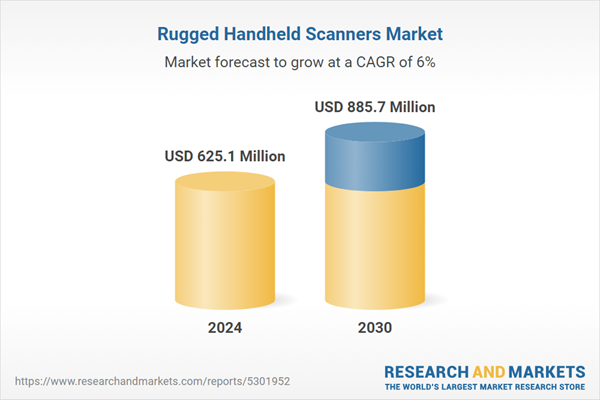Global Rugged Handheld Scanners Market - Key Trends & Drivers Summarized
What Are Rugged Handheld Scanners & Why Are They Essential in Industrial Applications?
Rugged handheld scanners are durable, portable devices designed to capture and read barcodes, QR codes, and other data formats in challenging environments. Built to withstand harsh conditions such as extreme temperatures, dust, moisture, and repeated drops, these scanners are essential for industries like logistics, warehousing, manufacturing, retail, healthcare, and field services. Unlike standard barcode scanners, rugged handheld scanners are engineered for high durability and longevity, making them ideal for demanding workflows where reliability and uptime are critical.The demand for rugged handheld scanners has grown significantly due to increasing automation in industries, the expansion of e-commerce, and the rising need for efficient supply chain management. These devices facilitate real-time data capture, improving inventory management, tracking, and operational efficiency across warehouses, distribution centers, and retail environments. In healthcare, rugged scanners are used for patient tracking, medication verification, and lab specimen management, where accuracy and durability are critical. The flexibility and durability of rugged handheld scanners make them indispensable in a wide range of applications, supporting faster and more reliable data collection and processing.
How Do Rugged Handheld Scanners Enhance Operational Efficiency & Productivity?
Rugged handheld scanners enhance operational efficiency by providing fast, accurate, and reliable data capture, even in the most challenging environments. In logistics and warehousing, these devices enable real-time tracking of inventory, reducing manual errors, speeding up sorting, and optimizing picking and packing processes. By scanning barcodes or RFID tags quickly and accurately, rugged handheld scanners support efficient inventory management, order fulfillment, and shipment verification. Their ability to handle high scanning volumes, operate in various lighting conditions, and withstand rough handling ensures consistent performance, minimizing downtime and maintenance costs. This reliability improves overall productivity and enables faster decision-making, making rugged handheld scanners critical for high-demand industries.In retail and point-of-sale applications, rugged handheld scanners streamline checkout processes, price verification, and product tracking, improving customer service and reducing transaction times. These devices can also be integrated with mobile POS systems, enabling staff to scan and process orders quickly on the sales floor, improving operational efficiency and customer experience. In the healthcare sector, rugged handheld scanners enhance patient safety by enabling accurate tracking of patient information, medication administration, and specimen handling. The rugged design ensures that scanners can endure frequent disinfection and rough handling, meeting the stringent hygiene and durability requirements of healthcare environments. By improving accuracy, speed, and reliability in data collection, rugged handheld scanners increase operational efficiency and support faster workflows across industries.
How Are Technological Advancements Shaping the Development of Rugged Handheld Scanners?
Technological advancements have significantly improved the performance, versatility, and user-friendliness of rugged handheld scanners, making them more effective for diverse applications. One of the major innovations is the integration of 2D imaging technology, which allows these scanners to read a wider variety of codes, including 1D barcodes, QR codes, and data matrices, on multiple surfaces and in various conditions. This versatility makes rugged handheld scanners more adaptable for applications ranging from retail to industrial asset tracking. The use of advanced optical sensors has also improved scanning speed, accuracy, and depth of field, enabling fast and efficient scanning even on damaged, poorly printed, or dirty barcodes.Another significant advancement is the incorporation of wireless communication technologies, such as Bluetooth, Wi-Fi, and 5G connectivity, which enables seamless integration with enterprise resource planning (ERP) systems, warehouse management systems (WMS), and mobile devices. This connectivity supports real-time data transfer, better inventory visibility, and instant access to information, improving operational efficiency and decision-making. The addition of GPS and RFID capabilities has further expanded the functionality of rugged handheld scanners, making them useful for location tracking and asset management in logistics, field services, and supply chain operations.
Enhanced durability features, such as impact-resistant housings, waterproof sealing, and extended battery life, have improved the usability and longevity of rugged handheld scanners in extreme conditions. Additionally, advancements in ergonomic design, touchscreen interfaces, and voice-command features have improved user comfort and ease of use, reducing operator fatigue during long shifts. Integration of AI and machine learning has enabled smart scanning features, such as automatic error detection, predictive maintenance alerts, and optimized scanning patterns, further enhancing productivity. These technological advancements have not only increased the performance and reliability of rugged handheld scanners but also expanded their applications across industries, supporting more efficient and accurate data collection in demanding environments.
What Factors Are Driving Growth in the Rugged Handheld Scanners Market?
The growth in the rugged handheld scanners market is driven by several factors, including increasing automation in logistics and warehousing, the expansion of e-commerce, the need for accurate and efficient data capture in field services, and advancements in scanner technology. As global supply chains become more complex and demand for faster deliveries increases, the need for real-time data tracking and automated processes has intensified. Rugged handheld scanners play a crucial role in achieving high accuracy and speed in inventory management, order processing, and shipping verification, making them essential for logistics, transportation, and e-commerce sectors.The expansion of e-commerce, driven by the shift toward online shopping, has increased the demand for efficient warehouse management systems, where rugged handheld scanners are used extensively for picking, packing, and shipment tracking. In the healthcare sector, the growing focus on patient safety and compliance with regulatory requirements has led to increased adoption of rugged handheld scanners for tracking patient records, medications, and medical equipment. In manufacturing and field services, these devices are used for asset management, quality control, and maintenance tasks, supporting improved productivity and reduced downtime.
Technological advancements, such as the development of multi-modal scanning, RFID integration, and AI-enhanced scanning capabilities, have increased the versatility and effectiveness of rugged handheld scanners, driving their adoption across various industries. Emerging markets, particularly in Asia-Pacific and Latin America, are experiencing rapid growth in retail, logistics, and healthcare infrastructure, creating strong demand for rugged handheld scanners. The rise of Industry 4.0, IoT-enabled devices, and smart factories has further expanded the applications of rugged handheld scanners, as they support real-time data capture, connectivity, and automation. With ongoing innovations, increasing demand for automation, and expanding applications in logistics, retail, healthcare, and manufacturing, the rugged handheld scanners market is poised for sustained growth, driven by evolving technology and global efforts toward digital transformation and operational efficiency.
Report Scope
The report analyzes the Rugged Handheld Scanners market, presented in terms of market value (US$ Thousand). The analysis covers the key segments and geographic regions outlined below.- Segments: Segment (Rugged Handheld Scanners).
- Geographic Regions/Countries:World; United States; Canada; Japan; China; Europe (France; Germany; Italy; United Kingdom; Spain; Russia; and Rest of Europe); Asia-Pacific (Australia; India; South Korea; and Rest of Asia-Pacific); Latin America (Argentina; Brazil; Mexico; and Rest of Latin America); Middle East (Iran; Israel; Saudi Arabia; United Arab Emirates; and Rest of Middle East); and Africa.
Regional Analysis
Gain insights into the U.S. market, valued at $162.7 Million in 2024, and China, forecasted to grow at an impressive 8.9% CAGR to reach $200.9 Million by 2030. Discover growth trends in other key regions, including Japan, Canada, Germany, and the Asia-Pacific.Why You Should Buy This Report:
- Detailed Market Analysis: Access a thorough analysis of the Global Rugged Handheld Scanners Market, covering all major geographic regions and market segments.
- Competitive Insights: Get an overview of the competitive landscape, including the market presence of major players across different geographies.
- Future Trends and Drivers: Understand the key trends and drivers shaping the future of the Global Rugged Handheld Scanners Market.
- Actionable Insights: Benefit from actionable insights that can help you identify new revenue opportunities and make strategic business decisions.
Key Questions Answered:
- How is the Global Rugged Handheld Scanners Market expected to evolve by 2030?
- What are the main drivers and restraints affecting the market?
- Which market segments will grow the most over the forecast period?
- How will market shares for different regions and segments change by 2030?
- Who are the leading players in the market, and what are their prospects?
Report Features:
- Comprehensive Market Data: Independent analysis of annual sales and market forecasts in US$ Million from 2024 to 2030.
- In-Depth Regional Analysis: Detailed insights into key markets, including the U.S., China, Japan, Canada, Europe, Asia-Pacific, Latin America, Middle East, and Africa.
- Company Profiles: Coverage of players such as Aceeca, Advantech, Cipherlab, Datalogic, Handheld Group and more.
- Complimentary Updates: Receive free report updates for one year to keep you informed of the latest market developments.
Some of the 37 companies featured in this Rugged Handheld Scanners market report include:
- Aceeca
- Advantech
- Cipherlab
- Datalogic
- Handheld Group
- Honeywell
- Juniper Systems
- Panasonic
- TouchStar Technologies
- Zebra Technologies
This edition integrates the latest global trade and economic shifts into comprehensive market analysis. Key updates include:
- Tariff and Trade Impact: Insights into global tariff negotiations across 180+ countries, with analysis of supply chain turbulence, sourcing disruptions, and geographic realignment. Special focus on 2025 as a pivotal year for trade tensions, including updated perspectives on the Trump-era tariffs.
- Adjusted Forecasts and Analytics: Revised global and regional market forecasts through 2030, incorporating tariff effects, economic uncertainty, and structural changes in globalization. Includes historical analysis from 2015 to 2023.
- Strategic Market Dynamics: Evaluation of revised market prospects, regional outlooks, and key economic indicators such as population and urbanization trends.
- Innovation & Technology Trends: Latest developments in product and process innovation, emerging technologies, and key industry drivers shaping the competitive landscape.
- Competitive Intelligence: Updated global market share estimates for 2025, competitive positioning of major players (Strong/Active/Niche/Trivial), and refined focus on leading global brands and core players.
- Expert Insight & Commentary: Strategic analysis from economists, trade experts, and domain specialists to contextualize market shifts and identify emerging opportunities.
Table of Contents
Companies Mentioned (Partial List)
A selection of companies mentioned in this report includes, but is not limited to:
- Aceeca
- Advantech
- Cipherlab
- Datalogic
- Handheld Group
- Honeywell
- Juniper Systems
- Panasonic
- TouchStar Technologies
- Zebra Technologies
Table Information
| Report Attribute | Details |
|---|---|
| No. of Pages | 133 |
| Published | December 2025 |
| Forecast Period | 2024 - 2030 |
| Estimated Market Value ( USD | $ 625.1 Million |
| Forecasted Market Value ( USD | $ 885.7 Million |
| Compound Annual Growth Rate | 6.0% |
| Regions Covered | Global |









